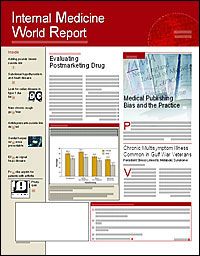Population Screening for H Pylori: A Cost Analysis
Given that gastric adenocarcinoma is the second most common cause of cancer mortality worldwide and that Helicobacter pylori is highly suspected as the main cause of distal disease, it has been postulated that widespread screening for H pylori might help reduce gastric cancer mortality. But would such screening be cost-effective? The investigators of a recent study (Gastro?enter?ology. 2005;129:1910-1917) have now shown that the answer is yes.
There are "accurate, inexpensive, and noninvasive tests for H pylori, and therapy for the infection is 80% to 90% effective," according to lead investigator Alexander C. Ford, of the Centre for Diges?tive Diseases, Leeds General Infirmary, Leads, United King?dom, and colleagues. Yet no country has thus far recommended screening on a widespread basis, possibly because only developed countries?where gastric cancer is becoming less common?can afford the screening and treatment programs.
This is the first long-term study to examine the economic impact of population-based H pylori screening and treatment on the costs of managing patients with dyspepsia.
This 10-year study included 2324 patients (aged 40-49 years) who tested positive for H pylori during a community screening program. They were assigned to 1 of 2 groups: eradication therapy consisting of ome?prazole (Prilosec) 20 mg, clarithromycin (Biaxin) 250 mg, or tinidazole (Tindamax) 500 mg, twice daily for 7 days, or placebo.
Key points
Gastric adenocarcinoma is the second most common cause of cancer mortality worldwide.
H pylori is suspected to be the main cause of distal disease.
Widespread screening could reduce mortality from gastric cancer, but no national guide-lines advocate such a strategy.
Screening for H pylori has been found cost-effective, but more research would be needed to ?confirm these results.
Both groups were sent a validated dyspepsia questionnaire by mail 10 years later, at which time primary care records were analyzed. Of the original group, 1864 (80%) were sent the questionnaire. A total of 1086 (47%) responded, and 919 (40%) consented to an examination of their primary care records?474 from the treatment group and 440 from the placebo group.
Analysis showed that dyspepsia-related costs were lower in those treated with eradication therapy than with placebo, with mean costs of $303 versus $420 per patient, respectively. Overall, eradication therapy was associated with a cost savings of $117 per patient (P = .03). The mean cost savings with eradication therapy versus placebo between 2- and 10-year follow-up was $74 per patient (P = .087). Further analysis showed that the majority of the 10-year cost savings was the result of fewer dyspepsia-related prescriptions in the treatment group (P = .01). In addition, more patients in the placebo group incurred dyspepsia-related costs (72.5% vs 48.5% in the treatment group).
Review of the 1070 questionnaires that included fully analyzable symptom information revealed an overall 40% prevalence of dyspepsia at baseline; 60% still had dyspepsia at follow-up. There was, however, a tendency toward a lower likelihood of being symptomatic at 10 years in the treatment arm (221 of 547 patients) compared with the placebo arm (228 of 523 patients), a non?significant difference.
The investigators noted that there was a "significant reduction in total dyspepsia-related health care costs. The savings made were greater than the initial cost of H pylori screening and treatment."
They added that a "search and erad?i?cate" strategy could be cost-effective but that more study is required.?R.M.
